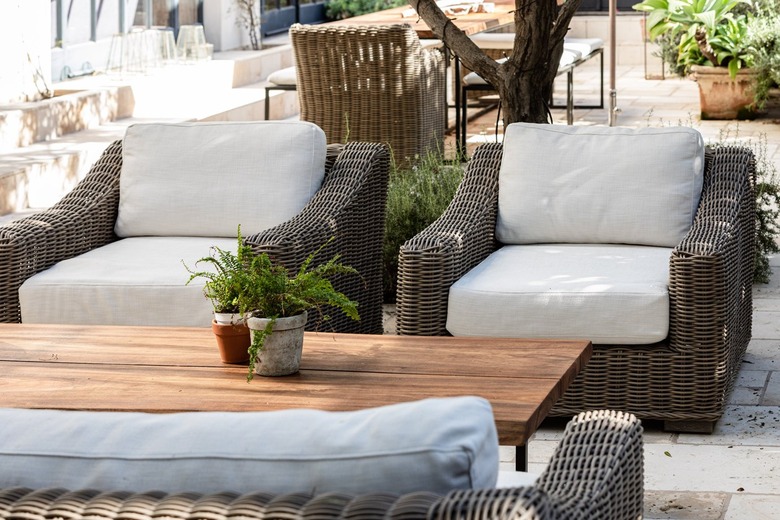How To Remove Mold From Outdoor Cushions
We may receive a commission on purchases made from links.
Keeping your outdoor cushions squeaky clean is always a challenge because of all the elements like rain, intense heat, or unsightly mold or mildew. Mold and mildew love to grow in dark, damp places, so they're all too likely to turn up on your lovely outdoor furniture sometime before summer's end, especially if you live in a hot, humid climate. The good news is, in most cases, moldy or mildewed outdoor seat cushions are easy to clean with water and the right cleaning products.
Cleaning Machine-Washable Cushions
Cleaning Machine-Washable Cushions
Before you start tossing cushions or covers in the washing machine, look for a care tag or cleaning instructions on the manufacturer's website if a legible care tag isn't available. If it turns out that the covers or the cushions themselves are machine washable, it's your lucky day.
Assuming your washer has sufficient capacity for agitating and spin-drying bulky seat cushions, add your usual detergent and set the machine for cold water and the gentlest cycle. When the cycle is complete, place the cushions on end in a sunny, well-ventilated area to air-dry.
To clean only the covers, remove and run them through a cold, gentle cycle while airing out the cushions in a well-ventilated spot. Let the covers air-dry before reusing them.
Tip
Although chlorine bleach is super effective at killing and removing mold and mildew, avoid using it as an additive when machine washing your cushions or covers unless the manufacturer's care instructions specifically allow it. If machine washing with detergent doesn't remove the mold from your cushions, you can try one of the solutions suggested below. Before treating your cushions with any type of cleaning solution, test it on an inconspicuous area to ensure that it doesn't fade or otherwise damage the fabric.
Cleaning Cushions That Aren't Machine Washable
Cleaning Cushions That Aren't Machine Washable
If you discover that your cushions aren't machine washable, try the following procedure:
- Put on a pair of
reusable rubber gloves and mix 1 part borax with 4 parts warm water in a bucket to make a deep-cleaning solution to tackle mold or mildew.
- Generously apply the solution to the fabric using a clean cloth or sponge and allow it to soak in for 15 to 30 minutes.
- After soaking, absorb excess moisture along with stains using clean, dry microfiber cloths.
- Then use a garden hose with a sprayer attachment to rinse the cushions thoroughly, followed by absorbing as much moisture as possible with fresh microfiber cloths.
- Leave the cushions to air-dry before using or storing them.
To help keep mold and mildew at bay between deep cleanings, fill a spray bottle with distilled white vinegar and spritz spots that appear to be new growth. Use a soft toothbrush or another type of soft brush to gently scrub the spots; then rinse with cool water, blot with a clean cloth, and let air-dry.
Using Bleach to Clean Acrylic Cushion Covers
Using Bleach to Clean Acrylic Cushion Covers
Some people prefer not to use chlorine bleach in and around their homes for safety reasons. If you're OK with bleach, though, you can use it to remove mold from acrylic cushion covers.
- Put on a pair of rubber gloves and mix 1 cup of household bleach and 2 cups of liquid soap, such as laundry detergent or dish soap, with 1 gallon of water.
- Apply the solution via a spray bottle or damp cloth and leave it to set for about 30 minutes.
- Then brush stained areas with a soft brush, rinse, and allow to air-dry.
Preventing Mold in the Future
Preventing Mold in the Future
Once you've dealt with existing mold or mildew, it's time to think about how to stop it from growing back. First, move your furniture to a brighter spot if it's sitting in the shade. In addition, you'll want to brush off your cushions daily, spot-clean as needed, and deep-clean at least once a year. You can also buy a mold spray for outdoor furniture to prevent mold from growing on the furniture frames and possibly spreading to your outdoor cushions or covers.
References
- Summer Classics: How to Remove Mildew From Outdoor Furniture
- Patio Productions: How to Remove Mold and Mildew from Patio Furniture, Cushions, & Umbrellas
- Polywood Blog: How to Clean Outdoor Cushions
- Cushion Factory: How To Clean Mildew From Your Outdoor Cushions
- Red Hanger Cleaners: Top 3 Tips for Cleaning Outdoor & Patio Furniture
- CoverStore: How to Clean Outdoor Cushions
- Fantastic Cleaners: How to Clean Outdoor Furniture Cushions
